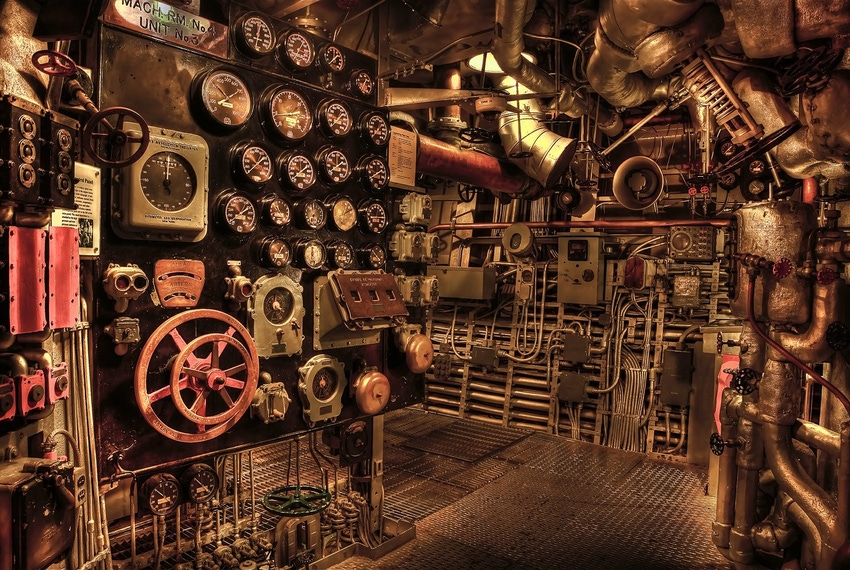The 3 Key Risks of 3D Printing Medical Devices
3D printing brings unique considerations for medical device engineers. But when used well, FDA's additive manufacturing guidance can give you a competitive advantage.
April 9, 2019

|
Without proper planning the variables 3D printing brings to medical device engineering can be as complex as this historic engine room. (Image source: GregoryButler from Pixabay) |
In October 2014, the US Food and Drug Administration (FDA) held a public workshop to gather feedback from the manufacturing and medical device communities with regards to additive manufacturing. The insights from that workshop eventually led to the FDA guidance on Technical Considerations for Additive Manufactured Medical Devices.
There are many unique and vital questions that medical device engineers need to answer with regards to additive manufacturing. While they are not difficult, it is new work compared to traditional applications. While the 30-page FDA guidance covers a number of important topics such as biocompatibility, software security, and acceptance testing, there are three key areas of risk and where implementation struggles exist that are worth delving deeper into.
1.) Software Workflow
The first risk is related to software use prior to production of the custom products. This category of work is described in the guidance as “Software Workflow.” Key elements include imaging, design manipulation software, and build preparation software.
Why is this important for additive manufacturing?
The approved design for an additive manufactured product is a general design (called “patient matched design” in the guidance) versus a specific design in traditional manufacturing. The specific design is exact in its design parameters with allowance for natural manufacturing variation. A general design (in additive manufacturing) has details that could change noticeably from patient to patient depending on the patient imaging process and what design tools are used to adapt the device to its recipient.
In a specific design the design tools are not vital for approval because the output is a specific, resulting in a well-defined product that has been thoroughly tested and evaluated. With general design (as it relates to additive manufacturing), on the other hand, the same product is never produced twice. The window of possible designs built is far broader than the natural manufacturing variation.
There are many questions to be asked in the additive manufacturing case: How do we know the design details are appropriate? How do we know there are no errors or mistakes? These errors could come from imaging, design modification, and manufacturing (build) preparation. How do we know we can meet the original design requirements? The design software needs to not only design the right product, but needs to include the checks to know we have executed the steps properly. Training of the software users is also important.
RELATED ARTICLES:
There is also a range of software tools used to capture the original image and then to prepare the design for fabrication. The design software needs to verify compatibility of the input tools and of the output tools. Of course the question can be asked, how many tools are needed to be checked? Who may have already checked compatibility? Can we leverage this third party work? What else has changed? What risks are exposed? These are all questions that are less important for traditionally manufactured parts.
Knowing the software checks included (and not included) for each of the tools for the overall software system is vital to ensure completeness, as well as efficiency. This can be accomplished through including an experienced user of the upstream and downstream software tools. It can also be assisted by producing product from a range of individuals during development, clinical, and validation efforts. This will help ensure unwelcome surprises are avoided.
2.) Material Reuse
Understanding the material aspects of the additive manufacturing process brings a wide range of new questions that need to be addressed and resolved. Creating a strategy approach to quickly and confidently answer these questions is essential.
Regardless of the manufacturing process used, the virgin material needs to be known. Since additive manufacturing also involves material melt or curing, it has additional considerations to ensure proper design. Material chemistry and mechanical properties need to be well understood for additive manufacturing.
As a comparison, consider injection molding. Injection molding can involve “regrind,” where material has previously been melted and solidified, and then ground up for reprocessing. How do we know this is acceptable? For injection molding the regrind was previously 100% melted. This is not the case for 3D printing, thus creating a more complicated situation to achieve a confident answer.
Additive manufacturing also brings in the complexity of the process energy (often a laser) potentially changing portions of (but not all of) the raw material. Did a certain material additive get directly impacted or transformed? Some of the reused material is still virgin. Some has been melted to some degree. How much do we have of each kind? How does this impact our material and process evaluation?
How many sets of product can be produced before the entire material bed is disposed of? What if only one small part is made? What if one large part with extremely complex features is produced? Or several smaller parts made with the same run? How does this impact the material properties of the powder?
|
Additive manufacturing processes create complex components and devices. But it also means medical device engineers need to be mindful of the materials and process. (Image source: Image by Christian Reil from Pixabay) |
3.) Process Development
The human body is full of variability and extremes. And the design system needs to be flexible enough to handle them.
Additive manufacturing brings new considerations for process development and the validation approach. The installation qualification (IQ) process would be very similar to any other process. It is always important to have the baseline setup for the system. This helps with trouble shooting and for potential movement of equipment in the future.
The operational qualification (OQ) process, however, is different from traditional processing because we have new questions to address. What are the desired operating parameters for a product that has never been produced before? While we can likely determine settings for a nominal or typical product, the OQ is about understanding the limits of a process. Thus, our OQ needs to determine settings for a range of potential products (much broader than the production tolerances).
A little bit of organization and thinking ahead would make this a reasonable request, but at the same time the answer is not obvious or intuitive. We need to ensure the proper software checks are available to create the proper design.
Operations will often reference the “manufacturers recommended settings” or process. The obvious question would be why is that recommended? What support or basis exists for the claim? And can that support be reviewed to ensure it is appropriate and comprehensive for the given application? If the equipment supplier has the information, that is acceptable. However, it needs to be something that is released to the equipment user to ensure assumptions are appropriate.
Also, how do we know secondary operations will be adequate? We have a highly variable design (more variability than a specific design). For example, in an extreme design condition could we have thinner walls than normal? How do we know an extreme process for finishing does not reduce the wall thickness even more, meaning our final product may not have the required strength to meet the end user requirements and customer needs?
We need to anticipate these situations and then perform the appropriate testing to confirm this wide range of operation.
The approach to performance qualification (PQ) may be different for additive manufacturing compared with a specific design situation as well. Many companies use a process capability approach for validation. By comparing the process outcomes to the design specifications, we can easily calculate a process capability index value to show acceptable performance. However, if we have a general design how do we do this? Our dimensional requirements float and are dependent on the initial images. PQ need to be performed on a range of potential images (designs) to gain the confidence that risk is limited.
The OQ work can be leveraged to keep the PQ effort simple, but we need to consider a range of image cases and of process parameters to provide the empirical evidence for process confidence. How we handle the floating requirements is an important point and needs to be understood prior to testing and data collection. One potential approach is to evaluate “deviation from target value.” While this generally makes sense, a look at the specific situation is required to confirm it does not introduce any unintended bias into our evaluation.
ESC BOSTON IS BACK! The nation's largest embedded systems conference is back with a new education program tailored to the needs of today's embedded systems professionals, connecting you to hundreds of software developers, hardware engineers, start-up visionaries, and industry pros across the space. Be inspired through hands-on training and education across five conference tracks. Plus, take part in technical tutorials delivered by top embedded systems professionals. Click here to register today! |
Perry Parendo is the founder and president of Perry's Solutions, Inc., a consultancy focused on Design of Experiment methods and new product development.
About the Author(s)
You May Also Like








